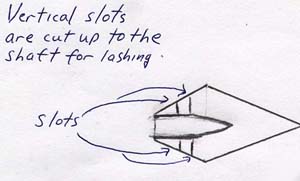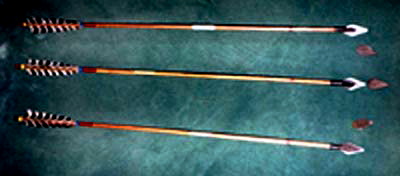
I use stainless steel stock that I inherited from my father and a sabre saw with a metal cutting blade attached to it to make razor sharp broadheads. Circular saw blades may also be used. Other steel stock may be used. I do not quench my stainless steel but if the metal is too soft you may heat treat it by heating it to a reddish glow with a propane torch and quenching it in olive oil. Heat treating should be done before the bevel is cut. My broadheads are 2 1/8 inches long and 1 inch wide. Clip the points at the rear of the broadhead to make it 3/8 of an inch thick. Refer to the diagram that I have illustrated below Check the game laws in your state to guarantee that your heads conform to their specifications, however. A water based marker may be used to trace out the shape onto the metal, if you use a petroleum spray to cool the metal. Pencil also works well for drawing on the metal
Place a piece of scrap pine under the metal to prevent it from vibrating dangerously and then clamp this set up onto your work bench. Use a couple of clamps. As you cut, move the clamps to clear the saw. Use safety glasses before starting your saw to be safe. Gloves will help protect your hands which should be kept well away from the saw. A variable speed saw will help you feel the correct cutting speed. Spray with a lubricant periodically to keep the metal from heating excessively. When the blank is cut, line the jaws of a locking pliers with fabric and tape to protect the metal. Lock the blank securely in the pliers. Grind or file the blank to remove any burrs and to bevel the edges.
You may also cut your stock with a sharp hacksaw. Just take you time.
To mount the head, first taper the point of your arrow with a 5 degree taper. Cut a 1 inch slot with the hack saw. Widen this with two hack saw blades held together. I use 5 minute epoxy to mount the head. Continually check for straight mounting. Let it dry the required amount of time. Make sure the taper on your arrow is smooth and of the slenderest profile. Sand as needed. Cut two slots about 3/16 of an inch apart on each side of the blade towards the rear with your blade clamped in a vice. Do not actually go as far as the arrow with the saw as it will weaken the connection. Wind sinew, artificial sinew or thread around the point and arrow. Add more epoxy to strengthen the attachment. If you are using real sinew on your arrow, then use hide glue. You may coat the sinew with pine pitch for waterproofing.
I prefer my heads honed and razor sharp. I use a coarse stone and finish with a fine one to produce a very sharp blade.


Copyright 1999 George C Tsoukalas
